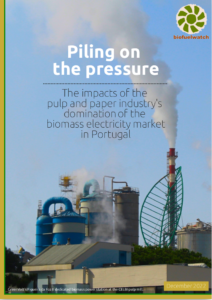 Piling on the Pressure: The impacts of the pulp and paper industry’s domination of the biomass electricity market in Portugal
Piling on the Pressure: The impacts of the pulp and paper industry’s domination of the biomass electricity market in Portugal
Click here to download the report
Summary:
Portugal’s pulp and paper sector is making record profits despite the current intersecting global crises. Its heavy investments in biomass electricity are a contributing factor, and it now produces almost 80% of the electricity generated from burning biomass in Portugal and controls over half of the dedicated biomass electricity capacity.
Underlying the sector’s focus on biomass electricity are generous renewable energy subsidies. This
incentive for burning woody biomass has encouraged the pulp and paper sector to decouple biomass burning from relying on by-products of the pulping process as a feedstock. Only around a third of the woody biomass burned by the sector comes from bark and other industrial by-products, with the vast majority being sourced directly from forestry operations.
The two most significant recent developments are Altri/GreenVolt’s 34.5MW electricity-only biomass power station in Figueira da Foz, and The Navigator Company’s neighbouring biomass boiler that replaced a fossil gas combined heat and power (CHP) plant. Both are dependent on large volumes of woody biomass directly from forestry operations, and have been financed as “green” developments.
In total, six electricity-only biomass power stations and five CHP plants associated with the pulp and paper industry burn around 2.8 million tonnes of woody biomass each year, more than any other sector. Almost two thirds of this comes directly from forestry operations. Pulp and paper companies claim that only forestry residues and industrial by-products are burned in their power stations, but far more woody biomass is burned by the biomass energy and wood pellet industries each year than could be available as genuine residues, as defined in Portuguese legislation.
The pulp sector claims that burning woody biomass helps it to meet its climate targets and reduce the risk of wildfires. However, biomass electricity often results in greater emissions than fossil fuel equivalents, and in recent years the scale of wildfires has only increased, particularly in forestry areas, as biomass electricity capacity has grown. On top of this, the over-extraction of woody biomass from forest areas is harming soil health and adding to pressure for the expansion of harmful eucalyptus plantations.
Three key areas of action that must be taken are:
- The introduction of an immediate moratorium on new biomass electricity capacity, and ending its eligibility for renewable energy subsidies;
- A cap on woody biomass consumption at pulp mills so that only secondary biomass (i.e. pulp mill and other wood processing by-products) are used as feedstock for energy generation;
- For subsidies for biomass electricity generation to be redirected towards climate mitigation and fire risk reduction techniques that incentivise the conservation and regeneration of native forests.
